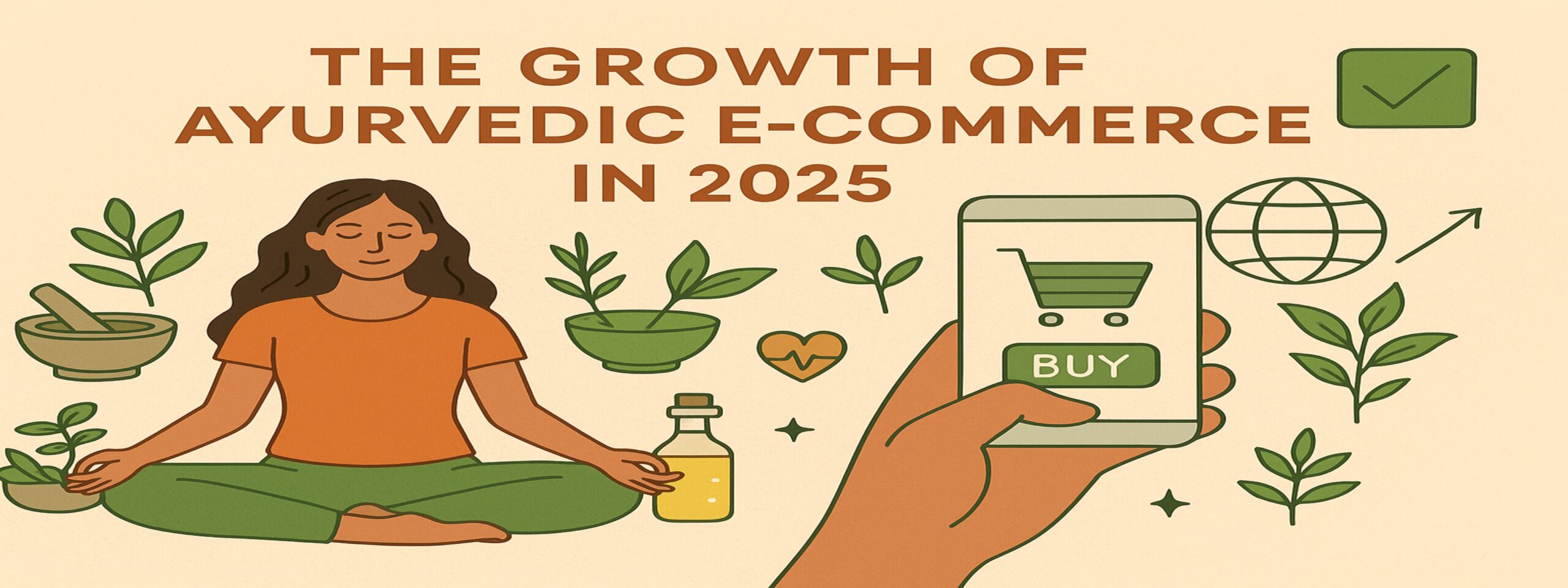Introduction: Ayurveda Goes Digital in 2025
Ayurveda, India’s 5,000-year-old holistic healing system, is witnessing a massive digital transformation in 2025. What was once confined to wellness retreats and traditional dispensaries has now evolved into a booming Ayurvedic e-commerce industry. With rising global interest in natural remedies, personalized health, and sustainable products, Ayurveda has found a new home — the online marketplace.
According to a 2025 report by the Indian Wellness Market Association, the Ayurvedic e-commerce sector has grown by over 40% year-on-year, driven by the global shift toward holistic living, increased digital literacy, and the post-pandemic wellness revolution.
Let’s explore the key trends, innovations, and challenges shaping this new era of Ayurveda in the digital world.
The Digital Boom in Ayurvedic Wellness
1. Post-Pandemic Health Awareness
The COVID-19 pandemic permanently changed consumer behavior, pushing millions toward natural immunity boosters, adaptogenic herbs, and preventive healthcare. Ayurvedic products like Chyawanprash, Ashwagandha, and Turmeric capsules became top online sellers.
According to Statista, searches for “Ayurvedic immunity products” rose by 230% between 2020 and 2024, setting the foundation for explosive e-commerce growth in 2025.
2. Rise of Direct-to-Consumer (D2C) Ayurvedic Brands
Brands like Kapiva, The Ayurveda Co., and Dabur’s online arm are redefining how Ayurveda reaches customers. By cutting out middlemen and selling directly through e-commerce platforms, these companies offer personalized wellness kits, subscription-based herbs, and virtual consultations with Ayurvedic doctors.
This D2C revolution ensures authenticity, transparency, and faster delivery — a must in today’s digital wellness economy.
Key Market Trends Driving Ayurvedic E-Commerce in 2025
1. AI-Powered Personalization
Artificial intelligence is enabling personalized Ayurvedic recommendations. Platforms now analyze a user’s dosha type, stress level, and sleep pattern to suggest suitable herbs, oils, or diets. For example, an AI chatbot might recommend Ashwagandha tea for Vata imbalance or Triphala capsules for digestive detox.
2. Global Export Growth
International consumers, especially in the US, Europe, and Japan, are turning to Ayurveda for preventive healthcare. Export-focused e-commerce platforms are leveraging multilingual websites and FDA-compliant labeling to reach new markets.
India’s Ayurvedic exports are projected to exceed $1.5 billion by 2025, according to the Ministry of AYUSH.
3. Influencer-Driven Awareness
Ayurvedic influencers, doctors, and wellness bloggers are bridging the gap between tradition and modernity. Platforms like Instagram and YouTube host thousands of creators promoting Ayurvedic skincare, detox regimens, and herbal tonics — creating a trusted ecosystem of digital word-of-mouth.
Challenges Facing the Ayurvedic E-Commerce Sector
1. Product Authenticity and Regulation
The rapid digital boom has also led to an influx of counterfeit or unverified products. Many lack standardization, lab testing, or AYUSH certification, raising consumer safety concerns. To maintain credibility, platforms must ensure quality assurance, transparent sourcing, and proper labeling.
2. Educating the Modern Consumer
Many international buyers are unfamiliar with Ayurvedic terminology or dosha theory. E-commerce platforms are now investing in educational content — blogs, quizzes, and digital consultations — to make Ayurveda more accessible and trustworthy.
The Future of Ayurvedic E-Commerce: What’s Next?
1. Integration of Tele-Ayurveda
By 2026, expect to see AI-backed Ayurvedic teleconsultations integrated directly into shopping apps. Customers will chat with certified Ayurvedic practitioners before purchasing herbal products — bridging the gap between ancient healing and modern convenience.
2. Sustainability and Green Packaging
Eco-conscious consumers are pushing for plastic-free, biodegradable, and refillable packaging. Many Ayurvedic brands are already adopting carbon-neutral supply chains and cruelty-free certification to appeal to global audiences.
3. Blockchain for Supply Chain Transparency
Emerging technologies like blockchain will soon verify product origins — from sourcing of Brahmi or Shatavari herbs to their packaging. This transparency can build global trust and further legitimize Ayurvedic e-commerce.
Conclusion: Ayurveda’s Digital Renaissance
The year 2025 marks a historic milestone — the fusion of ancient Ayurvedic wisdom with digital innovation. As consumers seek natural, ethical, and personalized health solutions, Ayurvedic e-commerce stands at the forefront of this revolution.
From herbal teas to virtual wellness consults, Ayurveda’s online evolution proves that timeless traditions can thrive in the modern marketplace. The future is not just digital — it’s Ayurvedically digital.
FAQs
1. What is Ayurvedic e-commerce?
Ayurvedic e-commerce refers to selling Ayurvedic wellness products and services through online platforms, including herbs, supplements, and consultations.
2. Which brands lead in Ayurvedic e-commerce?
Top brands in 2025 include Dabur Online, Kapiva, The Ayurveda Co., and Just Herbs.
3. How big is the Ayurvedic e-commerce market in 2025?
The market is estimated to cross $2.8 billion globally, driven by digital health adoption and increased awareness.
4. Is Ayurvedic e-commerce safe?
Yes, when products are AYUSH-certified, lab-tested, and purchased from reputable platforms. Always check labels and certifications before buying.
5. What’s the future of Ayurvedic e-commerce?
The future involves AI personalization, tele-Ayurveda, and sustainable packaging, blending holistic health with cutting-edge technology.

